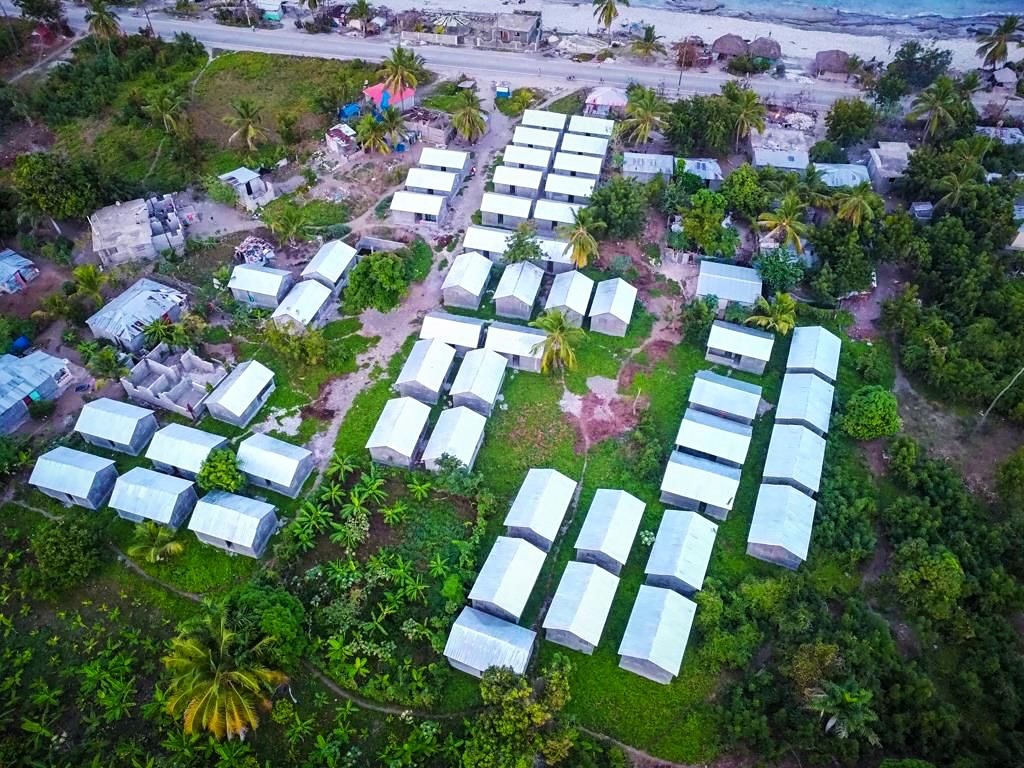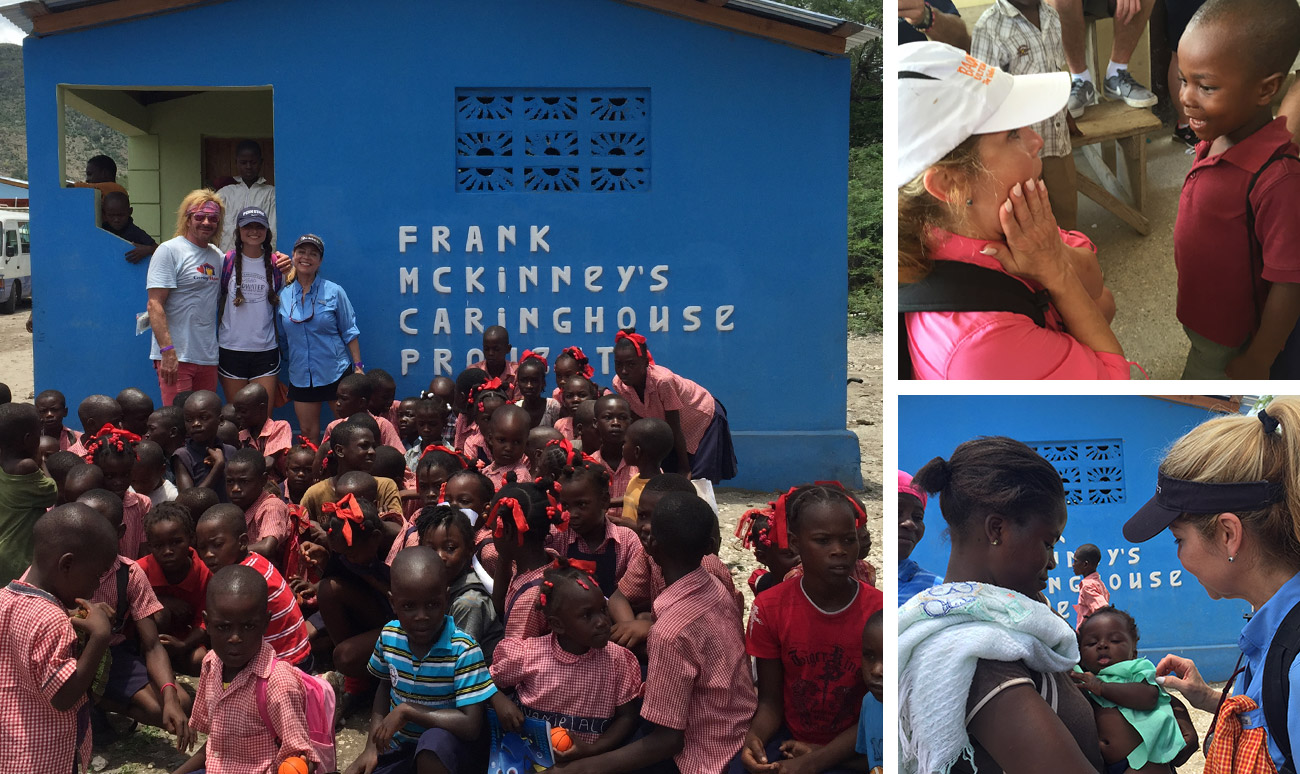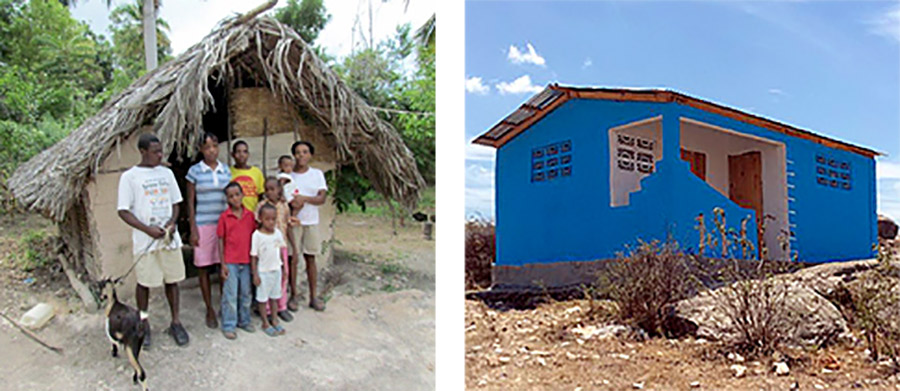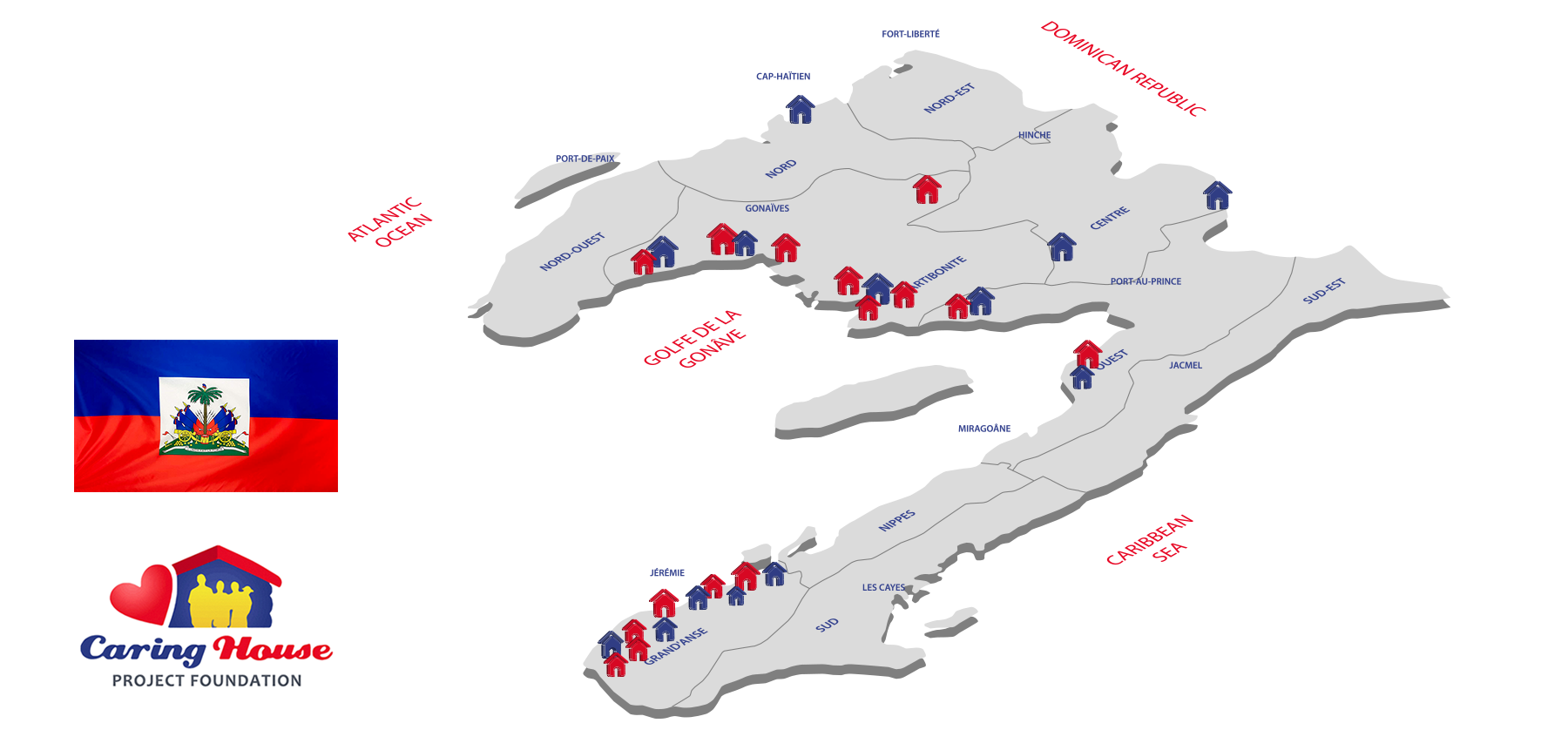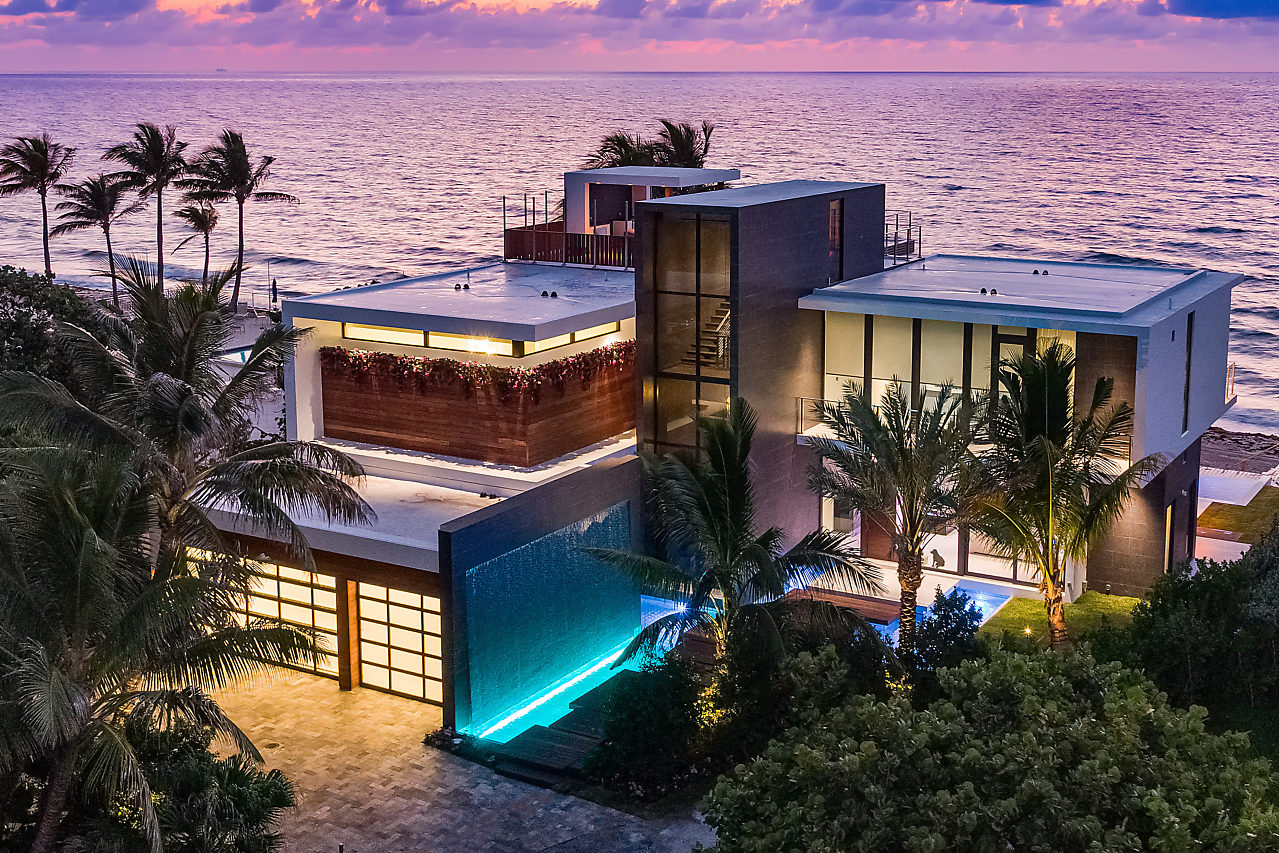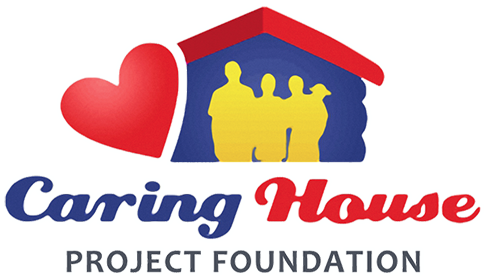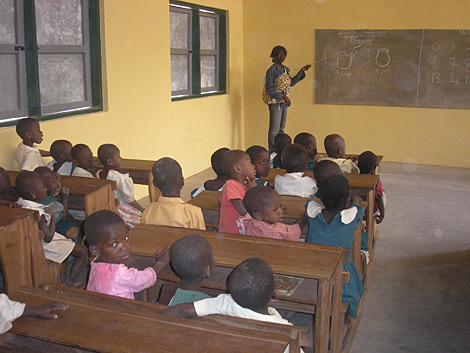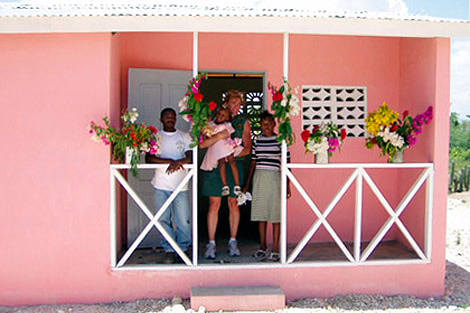Also in 2009, in Kalsegra, West Ghana, Africa, we built a school known as “The School of Two Trees” for 300 K-8th graders. We provided a clinic, sustainable farming and necessary farming equipment.
In 2010 we finished our three villages in Terre Rouge, Fond Rouge Torbek and Paroty, Haiti. These three villages totaled 100 homes, and provided shelter to over 800 men, woman and children who had none before.
Also in 2010 three more self-sufficient villages:
- Built a new village in Chameau, Haiti (50 houses, 50 latrines, 50 goats, 100 fruit trees, 1 mule).
- Built a new village in Mannuel, Haiti (50 houses, 50 latrines, 50 goats, 100 fruit trees, 1 mule.
- Built a new village in Mahotiere/Rampa, Haiti (50 houses, 50 latrines, 50 goats, 100 fruit trees, 1 mule.
Please visit our donation page to make your much needed contribution.
In 2011, CHPF accomplished the following (3 more villages + help in the US):
- In Paroty, Haiti, created then built a self-sufficient village that contained 50 homes (housing up to 400 people), sanitation facilities, 1 mule and renewable food sources (fruit trees, goats, chickens, pigs, etc).
- In Makandal, Haiti, built a smaller self-sufficient village contained 10 larger homes (housing up to 100 people), sanitation facilities, 1 mule and renewable food sources (fruit trees, goats, chickens, pigs, etc).
- Provided expedient emergency relief (cholera, earthquake, etc) in Haiti in the form of food and hundreds of bio-sand water filters producing up to 1000 gallons of clean drinking water a day.
- Given the economic challenges domestically, CHPF focused some of its efforts here at home as well, with 10-15% of our donors dollars staying here in the U.S.
In 2012, with the help of the Martel Alliance and Hope to Haiti, we built a seaside village in Anse Rouge, Haiti containing:
- 40 concrete houses
- 20 concrete latrines
- 1 2,000 sq. ft. community center and fishing cooperative
- 4 15-foot fiberglass boats w/ 4 15hp motors
- 1 generator
- 2 freezers
- And 1 underground fuel storage tank
In 2013, with your help, Caring House Project Foundation completed the following:
In St Marc (Parish of the Cross) & Roseaux, Haiti…
Provided 150 new concrete homes, 150 concrete latrines, 1 large community center/clinic/school, 150 female goats, 10 large water filtration systems and 600 fruit trees – all at no cost to the villagers! See the before and after photos for 2013 below.
In 2014 Caring House Project finished it’s 21 self-sufficent village in Ravine a’ Couleuvre, a small Haitian enclave near the Town of L’Estere (pop 3,000). RAC now contains 40 concrete/steel homes, 1 – 2,500 sq. ft. concrete church and community center, 20 concrete latrines, 1 water well, 40 water filtration systems, 40 goats and 80 chickens. This new village benefits 400+ children and their families!
Completed in 2015: Guernsey Family Village
The new Guernsey Family Village in Tante Jeanne, Haiti contains a chicken farm for commerce and to allow the village to be self-sufficient, 40 painted concrete and steel homes to accommodate families up to 10 people, 1 painted 2,500 sq. ft. concrete and steel church and community center, 20 concrete and steel latrines, 1 water well, 40 water filtration systems (one per house), 40 solar lights (one per house), and 40 solar stoves (one per house).
This new village benefits 400+ children and their families! All elements of the village will be provided to the residents of The Guernsey Family Village at no cost to them.
2016: Doug Doebler Village, Brinet, Haiti
The Doug Doebler village contains 40 concrete and steel homes to house a total of 400-500 children and their families, 1 large concrete and steel multi-purpose building containing a school/ church/ community center, 20 concrete and steel latrines, water well, water filters, solar lighting, and hundreds of goats and chickens.
2017: Yanik Silver Maverick Village, Guimbi, Haiti
The Yanik Silver Maverick Village is located in Guimbi Haiti, which is about 15 miles southwest of Gonaives and two hours north of the capital city of Port au Prince.
The village will contains 27 concrete and steel homes and ouses a total of 216 children and their families. It has 1 solar powered large concrete and steel multi-purpose building containing a school/ church/ community center, 16 concrete and steel latrines, water filters, solar lighting, and hundreds of goats and chickens.
As always, all elements of the Yanik Silver Maverick Village were provided to the residents at no cost to them.
2018: 2 villages in Bwa Blan and another in Bertang Haiti, known as Robyn’s Nest!
The 2 villages contained a total of 55 concrete and steel homes to house a total of 440 children and their families, 2 solar powered large concrete and steel multi-purpose building containing a school/church/community center, 28 concrete and steel latrines, water filters, solar lighting, and thousands of goats, chickens & fruit trees.
All elements of the three villages will be provided to the residents at no cost to them.
2019-2021: The Child Rescue Coalition Village and the Real Estate Worldwide Village in Gayatan, Haiti!
These 2 villages contain a total of 44 concrete houses, 1 shared concrete community center, 11 4-stall latrines with 44 total bathroom stalls, 1 solar array for the community center, 44 goats, 44 water filters, 2 entrance signs, 88 fruit trees, and 88 chickens. As always, all elements of the two villages will be provided to the residents at no cost to them.
2022-2023: The Mark Evans DM Family Village in Roseaux, Haiti.
50 solar-powered concrete homes each with a micro-flush toilet + 150 gallon cistern, community center (school, church, clinic), water tank to hold 1000 gallons of clean water, solar power in the community center to include lighting and plugs for phone charging, security wall, 50 goats (1 per house), 100 fruit trees (2 per house), 100 chickens (2 per house) and entrance sign showing the name of the village.
2024: Our 31st and 32nd self-sustaining Haiti villages in the last 22 years, The Family Village and The HERO Village in Anse Rouge, and we need your help!







